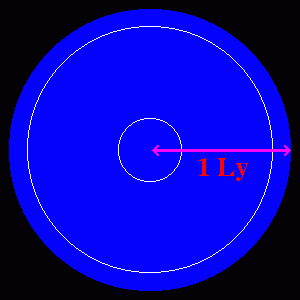
White Hole Cosmology was developed by Dr. Russell Humphreys and is more than just a solution to the problem of distant star light, it can serve as a respectable creation cosmology.
According to this cosmology, the universe would only be a few thousand years old by a clock on Earth, but by a clock at the edge of the universe it would be billions of years old.[1] The key to this model is the idea that time was much slower on Earth than distant parts of the universe, on day 4 of the creation. Likewise it relies on presuppositions or starting assumptions from the Big Bang. However grand that it is based in current scientific trends and therefore considered scientific, most importantly it is purely biblical in nature which is vital to provide for a model based on creationism.
The Big Bang cosmology is based on what is called the Copernican Principle. It is the idea that the universe is the same everywhere, which is a basic starting assumption. While some popular literature implies a universe that has a boundary and center, the Copernican Principle implies there is no boundary or center. The Copernican Principle is an arbitrary, evolutionary assumption that relies upon man's word. On the other hand, the Bible, or word of God, implies that the universe has a boundary and that the Earth is near the center, thus providing substitute starting assumptions contradictory to that of the Copernican Principle.
This is important because gravity depends on a center of mass, which implies an edge to the mass. According to the Big Bang theory there is no edge and therefore no center and therefore no net gravitational force. In the biblical creationism context, the universe may have a boundary with a net gravitational force. The significance of this is the fact that gravity slows time which follows exactly what is predicted and demonstrated by experiment by the theory of General Relativity.
The expansion of the cosmos is evident from both red shift and the Bible.
Isaiah 40:22 (AV). It is he that sitteth upon the circle of the earth, and the inhabitants thereof are as grasshoppers; that stretcheth out the heavens as a curtain, and spreadeth them out as a tent to dwell in: |
Genesis 1:1-5 (AV)
|
According to the white hole cosmology the, "deep" was a sphere of water about 2 ly (light years) in diameter, containing all the mass in the universe. The Earth was a formless undefined region of water at the center.
The entire mass is inside a black hole about one thousand million ly across that makes gravity compress and heat the deep, probably starting nuclear fusion.
Genesis 1:6-8 (AV)
|
The term firmament simply refers to an expanse or a space. God starts expanding this initial universe for a space between the water above the firmament and the water below the firmament. Some water stays inside the space and is later used by God to make the sun, moon, and stars.
Today the water above the firmament is still out there. It is assumed to be 20 billion ly out and beyond the farthest galaxy.
Psalms 148:1-4 (AV)
|
By day 3, Earth time, the expansion reaches the event horizon and the expansion starts pulling matter out of the event horizon. The black hole becomes a white hole. A white hole is the mathematical opposite of a black hole.
The initial collapse of the white hole results from matter exiting the event horizon, and it is powered by the expansion. It shrinks to a little larger than Earth in about a day Earth time, reaching that point on day four.
The event horizon does not shrink to a point; after all black holes do not form from a point. So the final collapse of the white hole is not characterized by a shrinking event horizon, but by a shadowing gravity well with the Earth at the center. The Earth emerges from the event horizon as the gravity well does and just as it ceases to exist. The gravity well is then reduced to Earth's own gravity.
Near the event horizon, time slows and actually stops. On Earth the process takes less than a day, but billions of years in the rest of the universe. The stars were made at this time and distant starlight has time to reach Earth. After the gravity well is gone the rest of the solar system is created.
During the six days of creation on Earth, billions of years passed at the edge of the universe, so that the age of the universe when Adam saw it was six days, according to Earth's standard of time. But the light from distant stars would still have time to reach us; thus the result would be that distant objects would appear, despite the distance and the finite speed of light.
Here is a simple comparison between the Big Bang and White Hole Cosmologies.
| Bounded | + | Relativity | = | White Hole Cosmology. |
| Unbounded | + | Relativity | = | Big Bang Cosmology. |
The basics of this theory are scientifically sound. If the universe is bounded, clock rates must be different and if the universe was much smaller in the past, clock rates were very different. Time dilation allows plenty of time in deep space for physical processes to occur, such as most of the theoretical stellar life cycles of galactic collisions and galactic wind-up.
Essentially, according to this model, God used relativity to let us see a young universe, according to time on Earth, which was slow on the fourth day of creation. This solution to the distant starlight problem is both scientifically and Biblically sound. The main problem is that it is difficult to test.
|
||||||||||||||||||||